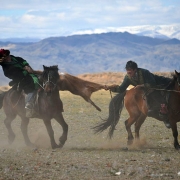The World Nomad Games is perhaps the coolest festival to see Central Asian nomads in action. But this one ancient sport may be repulsive to watch.
The 3rd World Nomad Games opened in Kyrgyzstan to spectacular fireworks and entertainment on the shores of Issyk Kul Lake yesterday. Over 400 participants from 30 countries joined in the international ethnocultural festival, according to the festival’s press statement.
The one week festival welcomed ethnic groups from all over the Central Steppe to celebrate their rich nomadic heritage.
The Central Steppe or Kazakh Steppe is a flat treeless grassland that extends from the Ural Mountains to Dzungaria in northwest China.
The horse-mounted nomads of central Asia are one of the world’s exuberant cultures. However, their culture and traditions are fast disappearing with globalization.
The Games was inaugurated in 2014 with the goal to revive and preserve nomad culture and Kyrgyz national sports. They range from eagle hunting to foot archery and equestrian games like er ernish, a form of wrestling on horseback.
Kok-Baru and Genghis Khan
One popular equestrian game that would be too gory to watch is kok-boru (blue wolf in Kyrgyz language). It’s akin to polo game except the object is a decapitated goat or carcass instead of a ball.
Two horse-mounted teams face off in a field, as they attempt to grapple control and hurl the carcass into the opponent’s goal.
“It’s like rugby on horses,” said former American competitive bull rider, Creed Garnick, in his interview with the Washington Post. Garnick lead the first American team to compete at the World Nomad Games in 2016.
Animal rights groups would abhor this game, which, in most competitions require freshly slaughtered goats, not fake carcasses.
UNESCO in 2017 inscribed kok-baru on the List of Intangible Cultural Heritage of Humanity.
The game is a way to showcase the Kyyrgyz’s identity and traditions. Variations of the game are played in neighbouring regions under different names. Ulak-tartysh in other Kyrgyz provinces, buzkashi in Afghanistan and kokpar in Kazakhstan.
“Kokpar is said to have originated with Genghis Khan’s early 13th century mounted raiders, although it may be even older”, said award winning author, Will Boast in his story, A Kingdom for a Horse.
Genghis Khan’s legacy is still going strong in this part of the world. This was revealed in a 2003 research led by geneticist Chris Tyler-Smith of UK-based Wellcome Trust Sanger Institute.
Tyler-Smith and his researchers reckoned that eight percent of men in 16 populations spanning Asia (and 0.5% of men worldwide) shared nearly identical Y-chromosome sequences with Genghis Khan.
Other activities at the Games feature traditional dances, fashion shows and bazaars where one can shop and test their haggling skills.

 ©Altaihunters
©Altaihunters